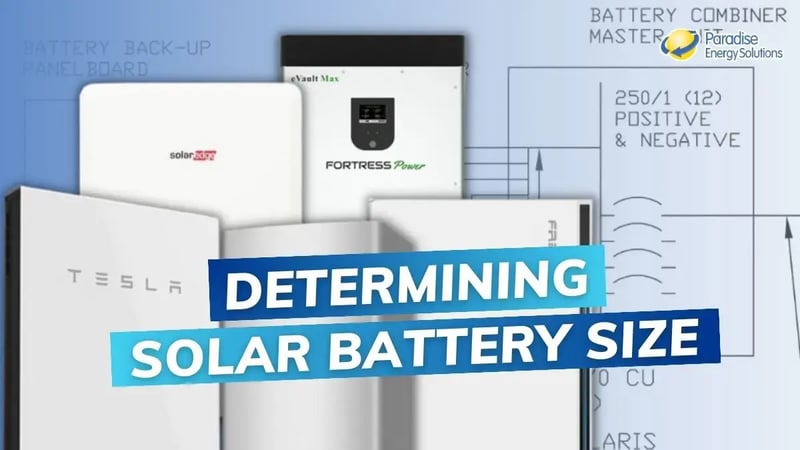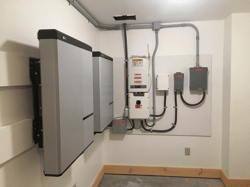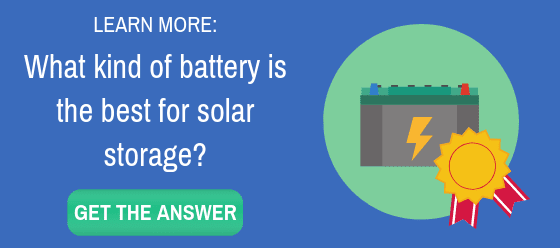How To Size Batteries for a Solar Panel Systems

Grid-tied solar doesn’t work when the electricity goes out. While it is frustrating, having a grid-tied system gives you many other benefits. But we’re not here to talk about those. We’re here to talk about how you can get electricity when the grid goes down.
As battery technologies improve, price decreases and efficiency increases. That means grid-tied solar with battery backups is becoming a more prevalent - albeit still expensive - option. With the proper setup, you can install batteries along with your new solar system or add batteries to your existing system. However, these systems aren’t meant to cover 100% of your normal usage, and you should take time to really think about which devices and appliances need to be powered when the lights go out.
So where do you begin with determining how much battery storage you need? Like so many other answers you’ll find on the internet, we’re going to say, “It depends.” But we’re here to help clear that up. We’ll show you what you need to think about when determining what size battery system you’ll need, and we’ll also give you some examples of how much you can power with batteries powered by solar.
What Devices Do You Want to Power During Outages with Battery Backup?
First and foremost, the size of your energy system will depend on your energy storage goals. Are you a homeowner looking to power a few essential appliances in case the electricity is knocked out for a few hours? Does your business or farm own a solar system and you’re looking to use batteries to shave off demand costs? Before reading on, give this some consideration.
While solar-charged batteries are a sustainable method of backup power, they can be expensive. In most cases, batteries are not meant to back up 100% of your normal electricity usage, and running on backed-up power has limitations.
Battery backups are meant for powering essential devices and appliances only.
Here is a list of things people typically power with their battery backup systems:
- Lighting
- Ceiling fans and/or air conditioning (often window units for one or a few rooms only)
- Refrigerator
- Medical equipment
- Personal electronics, modems, and routers
- Sump pumps and well pumps
What Is Your Budget For Solar Batteries?
 Another big factor that will influence your backup energy goals is how much you want to spend on batteries for your solar panel system. Unless you pay high demand charges, solar storage battery banks probably won’t save you any money (by high demand charges, we mean around $15 per kW—according to most research), but they will provide you with peace of mind.
Another big factor that will influence your backup energy goals is how much you want to spend on batteries for your solar panel system. Unless you pay high demand charges, solar storage battery banks probably won’t save you any money (by high demand charges, we mean around $15 per kW—according to most research), but they will provide you with peace of mind.
The truth is that solar batteries are not cheap. What we consider to be a basic battery setup will cost anywhere from $21,000 to $46,000+. This will provide enough storage to power small, lightly used loads during an outage (for example, a well pump, 2 freezers, and (4) 13W light bulbs).
A more advanced system that has the potential for whole-home backup will cost over $85,000.
Keep in mind that the installation cost will increase if the batteries are not installed at the same time as your solar panel system. If you’re adding batteries to an existing system, you may need to purchase new inverters and other equipment on top of the battery itself.
You may be able to use the 30% Federal Solar Tax Incentive. Several states have additional tax incentives or grants for installing batteries.
Things to Consider When Calculating The Size of a Solar Battery System
Once you have identified the appliances and devices you want to power during outages and have an idea of the required budget for your solar battery system, it's essential to delve into the technical aspects of accurately sizing your system. Factors such as the duration of backup power, rate of discharge, size of your backed-up appliances, and your solar system's production all play a crucial role in determining the size of your battery system. By carefully considering these technical factors, you can ensure that your solar battery system meets your energy storage needs effectively and efficiently.
The Duration of Backup Power/Storage Capacity
Once you know how much you want to spend on batteries, we can start getting into the technical stuff. First, how long would you like your batteries to provide power (this is known as your battery system’s storage capacity)? The longer you’d like your system to operate, the more batteries you will need.
Keep in mind how much space you have available to house the batteries. The more storage capacity you need and the more batteries you have, the larger the storage space will have to be. Depending on which type of battery you go with, they will either have to be stored inside or outside. If outside, they should be stored in a shaded and temperate area.
Rate of Discharge and Depth of Discharge
Another thing to note when determining the duration of your battery system is the rate of discharge or the amount of time it takes for your batteries to go from fully charged to their appropriate depth of discharge amount.
While it may seem unnecessary, it’s important not to use 100% of your batteries’ stored energy. Discharging your lead-acid batteries (and some lithium-ion batteries) down to 0% will shorten their lifespan. Depending on what the battery manufacturers advise, you may only be able to use 70% or 80% of your battery capacity.
The Size of Your Backed-Up Appliances/Battery Power
The next thing to consider is how many watts it takes to power what you’d like to back up. Think about how much instantaneous power it takes to run different applications and appliances. An emergency light may only take 60 watts, but a refrigerator may take 700 watts. This will play a significant part in estimating the battery bank size you need.
Your Solar System’s Production
Consider how many volts your PV panels are producing. Batteries charge when your solar system is generating more instantaneous power than you use at that moment. For a grid-tied system without battery backup, this power would go to the grid, and you would receive a credit or some other form of payment through net metering or another program. If you add a battery, your extra energy will charge up your battery, and any excess after that will pass to the grid.
If you rarely send solar-produced electricity back to the grid, you may have a hard time charging your batteries unless you add to your solar system or reduce your electric load. Another thing to keep in mind is your solar system's seasonality. Your system likely produces much more electricity in the summer than in the winter.
However, certain battery setups have the availability to charge batteries using grid power as well, meaning your battery backup won’t just be dependent on what your solar system produces.
Are Solar Batteries Right For You?
While solar batteries offer numerous benefits, they may not be the perfect fit for everyone. Some households might find a generator paired with solar panels to be a more suitable, cost-effective solution. If you're ready to explore your options to ensure your family's peace of mind, reach out to our team of solar experts. We're ready to help!
If you’re not sure you’d like to invest in batteries for solar energy but having electricity while the grid goes down is important to you, consider a generator. While these don’t run on sustainable energy like your solar-powered systems, they are a much more affordable option.





